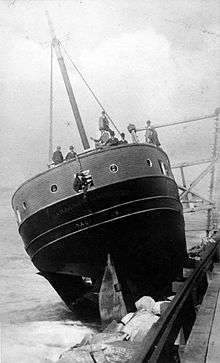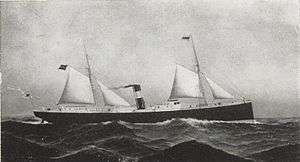SS Caracas (1881)
|}
The SS Caracas (1881–1889) was a coastal passenger steamship built by William Cramp & Sons in Philadelphia. She was the older sister ship to the Valencia. Both Caracas and Valencia served from New York City to Venezuela.[1] The short life of Caracas ended in 1889, when she ran aground in Yaquina Bay under the name Yaquina Bay.[2]
History
Since 1839, Red D Line had been operating a line of sailing vessels to Venezuela.[3] This continued for almost 40 years.[1] In the summer of 1879, it was decided to replace this service with steamships. At first, three German steamships were chartered to begin these operations.[3] Soon, it was realized that a more permanent specially built fleet was needed. As a result, the Red D Line ordered a pair of steamships from William Cramp and Sons in Philadelphia.[1]
The first of the pair, Caracas, was launched in 1881.[4] She weighed around 1,589 tons and left on her maiden voyage in June 1881.[1][4] The next year, her sister ship, the Valencia, joined the Caracas on a route from New York City to the Venezuelan cities of Laguayra, Puerto Cabello and Caracas.[1] This journey took 26 days to complete and was run twice a month. Both the Caracas and Valencia carried a combination passengers, cargo and mail. Both ships featured American crews.[1] Although identical to Caracas, the Valencia measured 5 ft (2 m) shorter in overall length.[5][6] From Caracas, the wooden steamer Maracaibo offered an extension service to the port of her namesake. Unlike Valencia and Caracas which flew the American flag, the Maracaibo flew the British flag.[1]

In 1888, having only served 7 years with the Red D Line, Caracas was sold for $175,000 to T. Egenton Hogg of the Oregon Pacific Railroad Company.[7] She was renamed Yaquina Bay.[5] She was intended to serve between Yaquina City, Newport and San Francisco, California, where the Yaquina Bay was to replace the earlier Yaquina City, which had run aground a year earlier. The Oregon Pacific Railroad also operated a railroad line between Yaquina City through Corvallis. By having a combination of steamship and rail service through Yaquina City and Corvallis rather than the usual route through Portland, over 300 miles could be cut from the journey between California and Chicago. With Yaquina Bay restarting the company's steamship service, travel time from California to Chicago could once again be shortened.[2] Unfortunately, Yaquina Bay was to never see this ambitious service. While being delivered on December 9, 1888, Yaquina Bay broke free from the steamer which was towing her and ran aground at the bay of her namesake near the remains of the Yaquina City and was declared a total loss.[5][2][8] Having lost a considerable amount of money from the wreck, Hogg stopped his ambitious project and left Oregon a broken man. Local residents believed that the Portland based companies purposely sabotaged both of Hogg's vessels, so as to prevent him from taking away potential customers from their business.[2]
Caracas' sister ship, Valencia, went on to serve with the Red D Line until 1898.[6] In 1897, she survived a pre-meditated attack from the Spanish cruiser Reina Mercedes.[9] She became a coastal liner on the west coast of the United States, serving from San Francisco, California to Alaska via Seattle, Washington.[6] For a short period of time, Valencia served as a troopship for the United States Army during the Spanish–American War.[10] In January 1906, Valencia suffered a similar fate to the Caracas when she ran aground off Vancouver Island. She was ripped apart and sunk by the pounding surf, killing 116 people.[6]
References
- 1 2 3 4 5 6 7 Preble, George H. (1895). "A Chronological History of the Origin and Development of Steam Navigation". L.R. Hamersly & Company. p. 398. Retrieved 9 September 2013.
- 1 2 3 4 John, Finn J.D. (1 December 2009). "The pirate-turned-railroad-man had big plans for Newport". Off Beat Oregon. Retrieved 14 September 2013.
- 1 2 United States Congress (1890). "Congressional Edition, Volume 2685". U.S. Government Printing Office. p. 228. Retrieved 8 September 2013.
- 1 2 Colton, Tim (27 May 2010). "Cramp Shipbuilding, Philadelphia PA". Shipbuilding History: Construction records of U.S. and Canadian shipbuilders and boatbuilders. Retrieved 8 September 2013.
- 1 2 3 E.W. Wright (1895 & 1961). "Yaquina Bay (steamer)". Magellan – Ship Biographies. Retrieved 14 September 2013. Check date values in:
|date=(help) - 1 2 3 4 Belyk, Robert C. Great Shipwrecks of the Pacific Coast. New York: Wiley, 2001. ISBN 0-471-38420-8
- ↑ "Afloat and Ashore – Daily Alta California, Volume 42, Number 14256". Reprinted. California Digital Newspaper Collection. 16 September 1888. p. 1. Retrieved 14 September 2013.
- ↑ "Gold-Carriers In Demand". San Francisco Call. California Digital Newspaper Collection. 83 (25): 9. 25 December 1897. Retrieved 9 September 2013.
- ↑ "Valencia Arrives Safely in Port". New York Times. 13 June 1897. Retrieved 8 September 2013.
- ↑ McSherry, Patrick. "The Transport Service". Spanish American War Centennial Website. Retrieved 8 September 2013.
External links
- The pirate-turned-railroad-man had big plans for Newport – Off Beat Oregon – An article explaining the ambitious plans of the Oregon Pacific Railroad and its owner T. Egenton Hogg.
- Atlantic and Caribbean Steam Navigation Co. / Red "D" Line – TheShipsList – Webpage explaining the fleet details of the Red D Line as well as some of its background history.
- Atlantic and Caribbean Steam Navigation Co. / Red "D" Line – Historia y Arqueología Marítima (In Spanish) – Webpage explaining a detailed history about the Red D Line and the SS Caracas.
 SS Caracas in Red D Line service. | |
| History | |
|---|---|
| Name: | SS Caracas |
| Namesake: | Caracas, Venezuela |
| Owner: |
|
| Port of registry: |
|
| Route: | New York City to Caracas via Laguayra and Puerto Cabello |
| Builder: | |
| Yard number: | 218[1] |
| Launched: | 1881 |
| Maiden voyage: | July 1881 |
| In service: | 1881 |
| Out of service: | 1888 |
| Fate: | Sold and renamed Yaquina Bay. |
| History | |
| Name: | SS Yaquina Bay |
| Owner: | |
| Port of registry: |
|
| Route: | Yaquina City, Oregon to San Francisco, California via Newport, Oregon (planned) |
| Acquired: | 1888 |
| In service: | 1888 (Planned) |
| Fate: | Wrecked |
| Notes: | Ran aground at Yaquina Bay in 1888 and declared a total loss. |
| General characteristics | |
| Type: | Ocean liner/Coastal passenger liner |
| Tonnage: | 1,200 tons[2] |
| Length: | 257 ft (78 m)[3] |
| Beam: | 34 ft (10 m)[3] |
| Notes: | Sister ship to the Valencia |
| Shipwrecks |
|
|---|---|
| Other incidents |
|
1887 | |
- ↑ "William Cramp & Sons Shipbuilders". Shipbuilding History. Retrieved 8 October 2013.
- ↑
- 1 2